Hamburg Prize for Theoretical Physics
Information about the award winners and their respective fields of research.
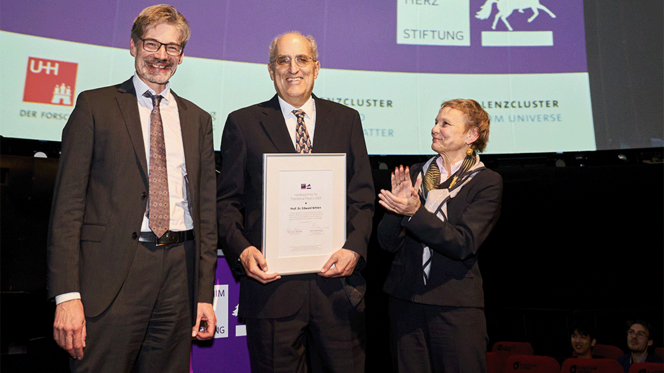
2014 - 2023
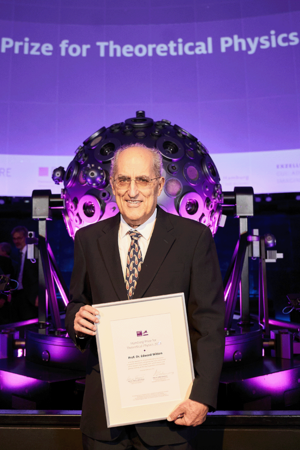
Edward Witten (2023)
Edward Witten is one of the most renowned and most frequently cited theoretical physicists of our time. For decades, he has provided important impetus for the development of a grand unified theory of physics that describes all the forces and building blocks of the universe. String theory is considered a promising candidate for this because it builds a bridge between quantum theory and Einstein's theory of general relativity. According to string theory, elementary particles such as quarks and electrons are different vibrational forms of the same tiny filamentary object. Thanks to this paradigm shift, on which the professor emeritus at the Institute for Advanced Study in Princeton had a significant influence, all four fundamental forces of nature can be described by a unified quantum theory of strings. Based on the work of numerous colleagues, Witten presented a proposal in 1995 on how the five alternative versions of string theory known at the time could be brought together as different limiting cases of a comprehensive theory, known as M-theory.
Edward Witten also provided important impulses in other areas of mathematical physics, from quantum theory to the physics of condensed matter, some with applications in gravitational theory and astronomy. His work on topological quantum field theory, for example, opened up new horizons for mathematicians in the late 1980s in understanding the geometric structures and laws of knots. Edward Witten has received many awards, including being the first physicist ever to receive the Fields Medal in 1990.
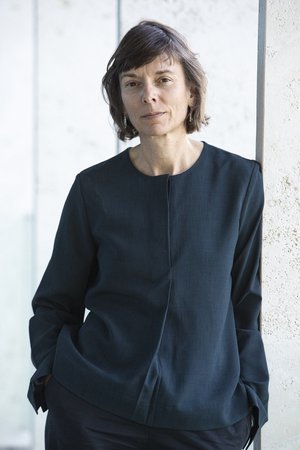
Nicola Spaldin (2022)
Nicola Spaldin was awarded the Hamburg Prize for Theoretical Physics 2022 for her pioneering research on multiferroics.
In 1997, a colleague at Yale University made a casual comment to Nicola Spaldin during a coffee break that was to leave her no peace: it was a pity that there were no ferroelectric materials that also exhibited ferromagnetic properties, i.e. were magnetizable. In the years that followed, she used quantum theory and computer models to investigate the conditions that must be met for crystalline chemical compounds to be both electrically polarizable and magnetizable. In 2000, she published a seminal article entitled "Why are there so few magnetic ferroelectrics?" The key finding: ferromagnetism and ferroelectricity are not fundamentally incompatible. One would only have to arrange the right atoms in a suitable crystal structure to obtain such multiferroic materials.
The breakthrough came in 2003 in cooperation with the research group led by physicist Ramamoorthy Ramesh of the University of California/Berkeley: Thin material films of bismuth ferrite produced in the laboratory showed multiferroic properties. After the publication in the scientific journal "Science", the number of publications on this topic increased by leaps and bounds. Today, the material is one of the most intensively researched multiferroics.
Since 2010, Nicola Spaldin has been driving the development of the new class of materials with her research group at ETH Zurich. Since the interplay between theory and experiment plays an important role in this, she runs her own laboratory for the synthesis of multiferroics and benefits from access to supercomputers and physical measuring instruments for material characterization at major Swiss research centers such as the Paul Scherrer Institute.
Nicola Spaldin studied chemistry and geology at the University of Cambridge and became interested early on in the interface between theoretical physics, chemistry and materials research. In 1996, she received her PhD from the University of California/Berkeley. She was a postdoctoral fellow at Yale University/New Haven before becoming an assistant professor and associate professor at the University of California/Santa Barbara. In 2006, she was appointed full professor at the same university. Since 2011, she has been Professor of Theoretical Materials Science at the Department of Materials Science at ETH Zurich.
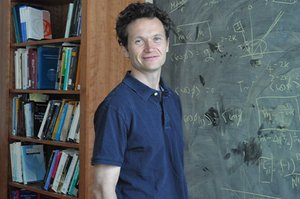
Eugene Demler (2021)
Russian-American researcher Eugene Demler received the Hamburg Prize for Theoretical Physics 2021. Demler, who has been a professor of physics at Harvard University in the U.S. since 2001 and moved to ETH Zurich in the fall of 2021, works to better understand strongly correlated quantum systems, from electrons in solids to rarefied atomic gases and photons.His research has profound implications in areas such as magnetism and superconductivity, many-body physics with ultracold atoms in optical lattices, nonlinear quantum optics, and pump-probe experiments in solids.
Eugene Demler is a world-renowned expert in theoretical quantum physics. It describes how electrons, atoms and other tiny objects behave. Demler's work has been instrumental in developing quantum simulators based on ultracold atoms, among other things. To understand complex materials, theorists often use simplified mathematical models, analyze them and compare the results with experimentally measured material properties. The problem is that even simple mathematical models describing correlated quantum systems cannot be precisely calculated when strong interactions between particles play a role.
Quantum simulators solve this problem with experimental systems that reproduce fundamental models of condensed matter physics. For example, by using laser beams to arrange ultracold atoms into periodic structures that form artificial crystals. Experiments with such artificial crystals allow scientists to study the properties of fundamental theoretical models in detail and to find out what is still missing to describe condensed matter systems precisely.
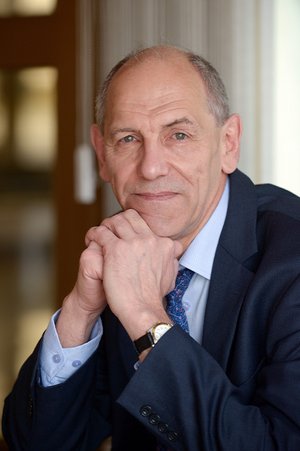
Valery Rubakov (2020)
In recent years, research teams around the world have gained important insights into the origin of the universe. They have also relied on the work of Valery Rubakov. For his research, the Russian physicist received the Hamburg Prize for Theoretical Physics in 2020. Rubakov, who died unexpectedly in October 2022, was a senior scientist at the Institute of Nuclear Research of the Russian Academy of Sciences in Moscow and a professor at Lomonosov Moscow State University.
The question of what we and the world around us are made of has always preoccupied people. Our matter is made up of atoms, which in turn are made up of protons, neutrons and electrons. In the classical standard model of elementary particle physics, which describes all known elementary particles and their fundamental forces with strong and weak interactions and electromagnetism, the proton is considered stable. Rubakov challenged this assumption and developed the theory for catalyzing proton decay by magnetic monopoles, called the Callan-Rubakov effect. This effect states that a magnetic monopole would produce the decay of protons, the basic building blocks of our matter, and leave an observable footprint in the form of neutrinos. Magnetic monopoles should have been created shortly after the big bang of the universe and theoretically still occur sporadically today.
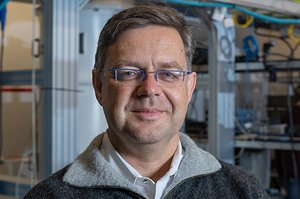
Matthias Troyer (2019)
The 2019 Hamburg Prize for Theoretical Physics has been awarded to Austrian scientist Matthias Troyer. Troyer was a professor at ETH Zurich and now works in quantum research for software manufacturer Microsoft. He received the prize for his contributions to the development of so-called quantum Monte Carlo algorithms.
They can be used to predict, on the basis of random numbers, how the smallest particles in quantum mechanical many-particle systems such as atoms or molecules influence each other. Troyer thus makes significant contributions to basic research and to the further development of quantum computers or even superconducting materials. He is one of the few internationally leading top researchers in this field. The Joachim Herz Foundation awarded the prize together with the Wolfgang Pauli Centre (WPC) and the Cluster of Excellence "CUI: Advanced Imaging of Matter" at the University of Hamburg.
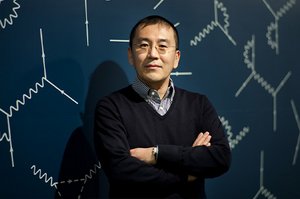
Hirosi Ooguri (2018)
The 2018 Hamburg Prize for Theoretical Physics was awarded to Japanese researcher Hirosi Ooguri. Ooguri, who works at the California Institute of Technology (Caltech) and the University of Tokyo, received the prize for his work on string theory - an important step toward laying the foundation for an all-encompassing theory of physics. Ooguri's research focuses on mathematical string theory, which could help resolve the last unanswered questions about the origin of the universe. It is considered the most promising approach to linking elementary particle physics with general relativity, which explains gravity, among other things. Ooguri has succeeded in making many physical phenomena calculable with the help of string theory. With his research on the quantum mechanics of black holes, he also ties in with the research of physicist Stephen Hawking.
Hirosi Ooguri joined Caltech in 2000 as a professor of theoretical physics. There he is the Fred Kavli Professor and director of the Walter Burke Institute for Theoretical Physics. At the same time, he is president of the Aspen Center for Physics and, since 2018, director of the Kavli Institute for Physics and Mathematics of the Universe at the University of Tokyo. Ooguri has received numerous awards. Among them, he is a Fellow of the American Academy of Arts and Sciences, and he received the Leonard Eisenbud Prize in Mathematics and Physics.
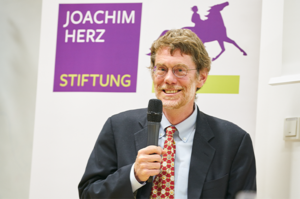
Andrew Millis (2017)
The 2017 Hamburg Prize for Theoretical Physics was awarded to Andrew Millis, professor at Columbia University in New York and deputy director for physics at the Simons Foundation. Millis receives the prize for his outstanding contributions to research in condensed matter physics, which deals with atomic and molecular interactions in solids and liquids. His work enables calculations that can be used, for example, to predict the electrical conductivity of a material very accurately. He is thus providing an important milestone in the search for materials in which superconductivity, the lossless conduction of electricity, is possible even at room temperature.
Andrew Millis studied physics at Harvard University and received his PhD from the Massachusetts Institute of Technology in 1986. He then worked as a research associate at Bell Laboratories in New Jersey. In 1996, Millis became a professor at Johns Hopkins University in Baltimore and moved to New Jersey three years later to Rutgers University. In 2001, Millis moved to Columbia University, where he served as chair from 2006 to 2009. He has been a professor of physics at Columbia since 2002. He has also served as associate director for physical sciences at the Simons Foundation, one of the major science-funding foundations in the United States, since 2011. On September 1, 2017, he also took up the position of co-director from the Center for Computational Quantum Physics at the Flatiron Institute of the Simons Foundation.
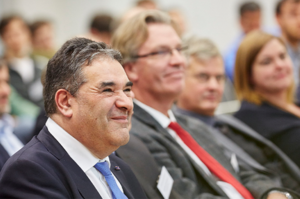
Mikhail Katsnelson (2016)
Mikhail Katsnelson works on quantum mechanical many-particle theory, strongly correlated systems and the quantum theory of magnetism, and graphene. In particular, his theoretical work on graphene is considered groundbreaking. He is considered a researcher with an exceptionally broad range of interests. His versatile expertise and diversity of methods came in handy in his work on graphene. The material has many remarkable properties and can be used in a wide variety of fields.
Mikhail Katsnelson, who published his first scientific papers at the age of 17, began his academic career in the former Soviet Union. After completing his master's degree in theoretical physics at Ural State University in Sverdlovsk, he received his doctorate in solid-state physics from the Institute of Metal Physics in 1980 and subsequently achieved his postdoctoral degree in 1985. Seven years later, he was appointed professor of solid-state physics and mathematical physics at Ural State University. After a brief stint in Sweden at Uppsala University, he has been teaching and researching as a professor at Radboud University in Nijmegen, the Netherlands, since 2004. Here he is head of the "Theory of Condensed Matter" research group.
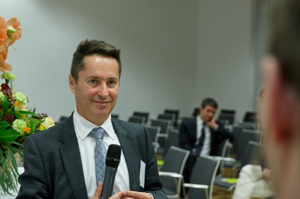
Ignacio Cirac (2015)
The 2015 Hamburg Prize for Theoretical Physics was awarded to Ignacio Cirac, Director of the Theory Department at the Max Planck Institute of Quantum Optics in Garching. Cirac received the prize for his outstanding research work in no less than three cutting-edge research topics: quantum information theory, quantum optics and the physics of many-particle systems.
Ignacio Cirac studied theoretical physics at the Complutense University of Madrid, where he received his PhD in 1991. Cirac then began his career as an associate professor at the University of Castilla-La Mancha. In 1996, he accepted an appointment as professor of theoretical physics at the Leopold-Franzens University in Innsbruck. Since 2001, he has been director at the Max Planck Institute of Quantum Optics and heads the Theory Department. Cirac develops methods to describe and control the world of atoms, molecules and photons according to the laws of quantum mechanics.
Some of his internationally groundbreaking work shows how quantum mechanical properties can be used safely and efficiently for the transmission and storage of information, which is particularly important for the development of quantum computers. However, Cirac's methods not only advance the field of quantum computing, but are also important in many other areas of physics, such as solid-state physics, superconductivity, and even for simulating models of particle physics.
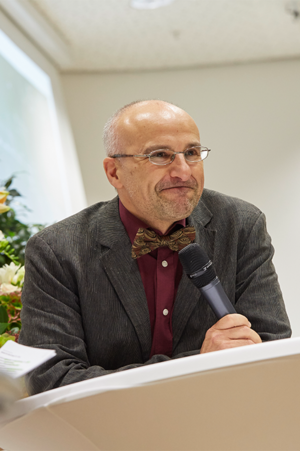
Antoine Georges (2014)
In 2014, the Hamburg Prize for Theoretical Physics was awarded to Antoine Georges, professor at the Collège de France and at the École Polytechnique in Paris and the University of Geneva. Georges receives the prize for his pioneering contributions to condensed matter physics, in particular for his novel methods for describing strongly correlated systems.
Antoine Georges received his PhD from the École Normale Supérieure in 1988. From 1989 to 1991, Georges followed an offer to work in the United States as a postdoctoral fellow. He then deepened his research concerning condensed matter physics when he returned to France in 1991 and led a research group at École Polytechnique from 2003. Since 2009, he has been a professor of condensed matter physics at the Collège de France, in addition to working as a professor at the University of Geneva. He is also director of the Center for Computational Quantum Physics at the Flatiron Institute in New York, founded in 2017.
The focus of his work is on the physics of materials with strong interactions among electrons. These materials have remarkable electrical properties. George's research in this area has greatly advanced the understanding of these materials and helps explain, calculate, and even predict their physical properties. His research thus makes important contributions at the interface of theoretical solid-state physics and the materials sciences.